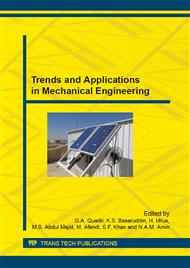[1]
G.H. Hu, Y.P. Chen, Z.D. Zhou and H.C. Fang, A genetic algorithm for the inter-cell layout and material handling system design, Int J Adv Manuf Technol. 34 (2007) 1153–1163.
DOI: 10.1007/s00170-006-0694-0
Google Scholar
[2]
I. Mihajlovic, Z. Zivkovic, N. Strbac, D. Zivkovic and A. Jovanovic, Using genetic algorithms to resolve Facility layout problem, Serbian J Manag. 2 (2007) 35–46.
Google Scholar
[3]
S. Jannat, A.A. Khaled, and Sanjoy Kumar Paul, Optimal solution for multi-objective facility layout problem using genetic algorithm, Proceedings of the 2010 International Conference on Industrial Engineering and Operations Management Dhaka, Bangladesh, January 9 – 10, (2010).
Google Scholar
[4]
Maricar G. Misola and Bryan B. Navarro, Optimal facility layout problem solution using genetic algorithm, World Academy of Science, Engg. and Tech., Int J Mechanical, Aerospace, Indus Mechat Engg. 7 (2013) 616-621.
Google Scholar
[5]
M.R. Ganesh, J. Dileeplal and Soni Kuriakose, Genetic – Simulated annealing algorithm for robust layout in dynamic facility layout problem, Int J Inno Res Adv Engg. 1 (2014) 288-293.
Google Scholar
[6]
A. Keivani, S.N. Rafienejad, M.R. Kaviani, H. Afshari, A simulated annealing for multi floor facility layout problem, Proceedings of the World Congress on Engineering and Computer Science, 2010, Vol II WCECS 2010, October 20-22, 2010, San Francisco, USA.
Google Scholar
[7]
Rhythm Suren Wadhwa1 and Terje K. Lien, Comparison and application of metaheuristic population-based optimization algorithms in manufacturing automation, Int J Comput Sci. 8 (2011) 19-30.
Google Scholar
[8]
R.M. Satheesh Kumar, P. Asokan and S. Kumanan, Design of loop layout in flexible manufacturing system using non-traditional optimization technique, Int J Adv Manuf Technol. 38 (2008) 594–599.
DOI: 10.1007/s00170-007-1032-x
Google Scholar
[9]
Xiangyu Kong, Sanyang Liu, Zhen Wang, Longquan Yong, Hybrid artificial bee colony algorithm for global numerical optimization, J Comp Info Sys. 8 (2012) 2367–2374.
Google Scholar
[10]
Nebojsa Bacanin and Milan Tuba, Artificial bee colony (ABC) algorithm for constrained optimization improved with genetic operators, Stud Inform Cont. 21(2012) 137-146.
DOI: 10.24846/v21i2y201203
Google Scholar
[11]
M. Saravanan and P.V. Arulkumar, Design and optimization for fixed area cellular layout problems. Int J Innov Sust Devel. 7 (2013) 91-109.
Google Scholar
[12]
Dervis Karaboga, Artificial bee colony algorithm. Scholarpedia, 5 (2010) 6915.
DOI: 10.4249/scholarpedia.6915
Google Scholar


